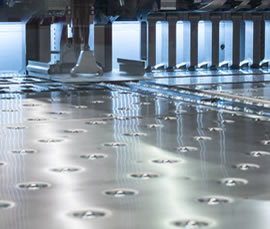
There are different processes available for cutting metal. Some manufacturing companies use torch cutting, whereas others use plasma cutting. Torch and plasma cutting both revolve around heat to slide through metal. Another cutting process, however, is shearing. Shearing supports many of the same materials as torch and plasma cutting. With that said, shearing offers some unique advantages that make it an attractive alternative.
What Is Shearing?
Also referred to as die cutting, shearing is a cutting process that’s defined by the use of one or more straight blades. It’s typically used to cut sheet metal. Shearing requires the use of a tool that consists of a punch and one or more straight blades. As the punch drops on the metal workpiece, the blade or blades will cut the workpiece.
It’s Fast
Shearing is faster than many other cutting processes. Manufacturing companies can quickly cut metal workpieces by running them through a shearing tool. They don’t have to wait for the shearing tool to “warm up.” As soon as the shearing tool is turned on, manufacturing companies can use it to cut metal workpieces. This makes shearing faster than other cutting processes, such as torch and plasma cutting.
Straight Edges
For straight edges, shearing is the way to go. The problem with other cutting processes is that they often result in jagged or deformed edges. After cutting a workpiece, manufacturing companies may discover that the edges are jagged, rough or otherwise deformed. Shearing doesn’t suffer from this problem. Thanks to its use of a punch and a straight blade, it will create straight and smooth edges.
No Chips
No chips are produced during shearing. Chips, of course, are pieces of excess material. With other cutting processes, chips are created as a byproduct. Manufacturing companies may cut a metal workpiece, resulting in the creation of chips. Fortunately, shearing typically creates few or no chips. It’s a highly efficient cutting process that prevents excess waste in the form of chips.
Supports Hard and Soft Metals
Shearing isn’t restricted to any single type of metal. Rather, it supports most types of metals, including hard and soft metals. Shearing tools are high-powered machines that can cut through most types of metals. Whether you’re trying to cut a sheet of aluminum or a sheet of stainless steel, you can probably use a shearing tool. Shearing supports a variety of hard and soft metals, which is one more reason why so many manufacturing companies prefer it over other cutting processes.
